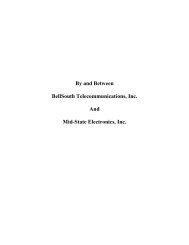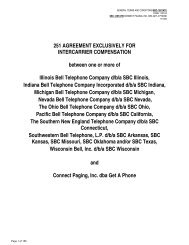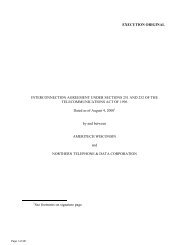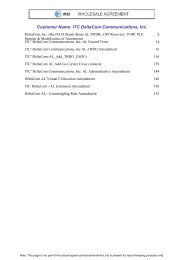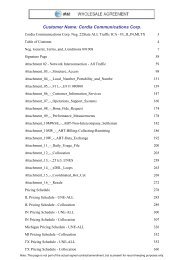Optical Telecommunications, Inc.
Optical Telecommunications, Inc.
Optical Telecommunications, Inc.
Create successful ePaper yourself
Turn your PDF publications into a flip-book with our unique Google optimized e-Paper software.
Version: 2Q05 Standard ICA<br />
07/06/05<br />
Attachment 3<br />
Page 12<br />
tandem. SWA, Type 2A CMRS or toll traffic routed to the local tandem in error<br />
will not be backhauled to the BellSouth Access Tandem for completion. (Type 2A<br />
CMRS interconnection is defined in Section A35 of BellSouth’s GSST).<br />
4.10.3.4 BellSouth’s provisioning of Local Tandem Interconnection assumes that OTI has<br />
executed the necessary local interconnection agreements with the other third party<br />
network providers subtending those local tandems as required by the Act.<br />
4.10.4 Direct End Office-to-End Office Interconnection<br />
4.10.4.1 Direct End Office-to-End Office one-way or two-way interconnection trunk<br />
groups allow for the delivery of a Party’s originating Local Traffic, ISP-Bound<br />
Traffic and IntraLATA Toll Traffic to the terminating Party on a direct end<br />
office-to-end office basis.<br />
4.10.4.2 The Parties shall utilize direct end office-to-end office trunk groups under any one<br />
(1) of the following conditions:<br />
4.10.4.2.1 Tandem Exhaust. If a tandem through which the Parties are interconnected is<br />
unable to, or is forecasted to be unable to support additional traffic loads for any<br />
period of time, the Parties will mutually agree on an end office trunking plan that<br />
will alleviate the tandem capacity shortage and ensure completion of traffic<br />
between OTI and BellSouth.<br />
4.10.4.2.2 Traffic Volume. To the extent either Party has the capability to measure the<br />
amount of traffic between OTI’s switch and a BellSouth End Office and where<br />
such traffic exceeds or is forecasted to exceed a single DS1 of traffic per month,<br />
then the Parties shall install and retain direct end office trunking sufficient to<br />
handle such traffic volumes. Either Party will install additional capacity between<br />
such points when overflow traffic exceeds or is forecasted to exceed a single DS1<br />
of traffic per month. In the case of one-way trunking, additional trunking shall<br />
only be required by the Party whose trunking has achieved the preceding usage<br />
threshold.<br />
4.10.4.2.3 Mutual Agreement. The Parties may install direct end office trunking upon mutual<br />
agreement in the absence of conditions (1) or (2) above.<br />
4.10.5 Transit Traffic Trunk Group<br />
4.10.5.1 Transit Traffic trunks can either be two-way trunks or two (2) one-way trunks<br />
ordered by OTI to deliver and receive Transit Traffic. Establishing Transit Traffic<br />
trunks at BellSouth Access and Local Tandems provides Intratandem Access to<br />
the third parties also interconnected at those tandems. OTI shall be responsible for<br />
all recurring and nonrecurring charges associated with Transit Traffic trunks and<br />
facilities.<br />
CCCS 113 of 261






